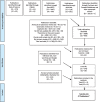A review of lesbian, gay, bisexual, trans and intersex (LGBTI) health and healthcare inequalities
- PMID: 30380045
- PMCID: PMC6761838
- DOI: 10.1093/eurpub/cky226
A review of lesbian, gay, bisexual, trans and intersex (LGBTI) health and healthcare inequalities
Abstract
Background: Lesbian, gay, bisexual, trans and intersex (LGBTI) people experience significant health inequalities. Located within a European Commission funded pilot project, this paper presents a review of the health inequalities faced by LGBTI people and the barriers health professionals encounter when providing care.
Methods: A narrative synthesis of 57 papers including systematic reviews, narrative reviews, meta-analyses and primary research. Literature was searched in Cochrane, Campbell Collaboration, Web of Science, CINAHL, PsychINFO and Medline. The review was undertaken to promote understanding of the causes and range of inequalities, as well as how to reduce inequalities.
Results: LGBTI people are more likely to experience health inequalities due to heteronormativity or heterosexism, minority stress, experiences of victimization and discrimination, compounded by stigma. Inequalities pertaining to LGBTI health(care) vary depending on gender, age, income and disability as well as between LGBTI groupings. Gaps in the literature remain around how these factors intersect to influence health, with further large-scale research needed particularly regarding trans and intersex people.
Conclusion: Health inequalities can be addressed via changes in policy, research and in practice through health services that accommodate the needs of LGBTI people. With improved training to address gaps in their knowledge of LGBTI health and healthcare, health professionals should work in collaboration with LGBTI people to address a range of barriers that prevent access to care. Through structural change combined with increased knowledge and understanding, services can potentially become more inclusive and equally accessible to all.
© The Author(s) 2018. Published by Oxford University Press on behalf of the European Public Health Association.
References
-
- Köhler B, Kleinemeier E, Lux A, et al.Satisfaction with genital surgery and sexual life of adults with XY disorders of sex development: results from the German clinical evaluation study. J Clin Endocrinol Metab 2012;97:577–88. - PubMed
Publication types
MeSH terms
LinkOut - more resources
Full Text Sources
Medical


